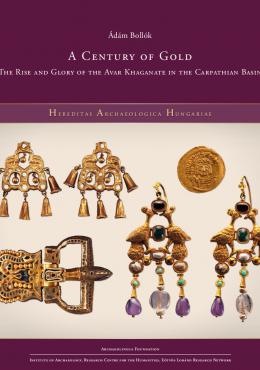A Century of Gold

A Century of Gold
| 11 533 Ft |
| Ár |
Hereditas Archaeologiae Hungaricae
Budapest, Archaeolingua, 2021
Puhakötés | Paper book
166 oldal, színes és fekete-fehér illusztrációkkal / 166 pages with colored and grayscale images
ISBN 978-615-5766-48-0
Ez a könyv magyarul is elérhető / This book is available in Hungarian.
Leírás
Az Avar Kaganátus fennállásának első évszázadát jellemző kivételes aranybőséget a ránk maradt régészeti leletek alapján jól ismerjük: számos, arany és más értékes tárgyban bővelkedő sírt tártak fel a régészek ebből az időszakból. Az avarok az 550–560-as években vándoroltak ázsiai szállásaikról előbb a kelet-európai sztyeppevidékre, majd a Kárpát-medencébe, és egy évtized leforgása alatt egy számos népet magába foglaló birodalmat hoztak létre. Az Avar Kaganátus felemelkedését és tündöklését az 560-as és a 620-as évek között több körülmény szerencsés együttállása tette lehetővé. Európai történetük első, név szerint ismert kagánja, Baján a sztyeppei történelemben többször feltűnő, karizmatikus uralkodó volt, akinek vezetői képességei elősegítették népének hadi sikereit. Európába érkezésükkor az avarok szövetségesre leltek a Keletrómai Birodalom uraiban, akik az északi határaikat fenyegető szomszédjaik megfékezését remélték az új katonai erőtől. E szövetség megkötésében központi szerepet játszott az avaroknak juttatott nagy mennyiségű arany és drága ajándék. A Keletrómai Birodalom anyagi támogatását élvező avarok gyors ütemben hajtották uralmuk alá Kelet-Európa, majd a Kárpát-medence különféle nyelvű és eredetű közösségeit. Ennek során egy olyan politikai alakulatot hoztak létre, amely később évtizedeken át képes volt rákényszeríteni a keletrómai szövetségest az egyre növekvő „aranyadó” megfizetésére. E juttatások jelentős hatással voltak az Avar Kaganátus társadalmi berendezkedésére és közösségeinek anyagi kultúrájára. Jelen kötet e folyamatokba nyújt betekintést az írott források és a régészeti leletanyag alapján megfogalmazódó tanulságok bemutatásával.
Description
The first century of the Avar Khaganate in the Carpathian Basin saw an extraordinary abundance of gold that is amply attested in the archaeological record: the burials dating from this period are lavishly furnished with gold articles and other precious objects. Migrating from their Asian homeland first to the Eastern European steppe region and thence to the Carpathian Basin in the 550–560s, the Avars forged a multi-ethnic empire within the span of a decade. The rise and glory of the Avar Khaganate, which coincided with the last century of Late Antiquity, was grounded in the fortuitous constellation of several circumstances. Bayan, the first khagan of the Avars’ European history known by name, was a charismatic ruler in the history of the steppe, whose leadership qualities were vital to the military achievements of his people. Upon their arrival to Europe, the Avars found an ally in the lords of the Eastern Roman Empire who, hoping that the new military power would curb their neighbours threatening their northern frontier, were willing to assist them. They gladly oiled the new alliance with gold and extravagant gifts. Bolstered with the Eastern Roman subsidies, the Avars subdued Eastern Europe and the diverse communities living in the Carpathian Basin. By uniting the strength of the vanquished peoples, the Avars built a powerful polity which through pressure and military campaigns successfully forced the Eastern Roman administration to pay increasingly larger tributes. This extorted wealth had a major impact on the Avar Khaganate’s social organisation as well as on the material culture of its communities. The present volume marshals the data from a wide array of written sources and the archaeological record to provide a better understanding of the dynamics of this process and of the insights that can be drawn from it
| |
|
|
1067 Budapest, Teréz krt. 13. |
|
|
|
|
Rólunk
Az Archaeolingua Alapítvány és Kiadó több, mint 25 éve foglalkozik régészeti, nyelvészeti, történettudományi és örökségvédelmi tárgyú publikációk és publikációsorozatok létrehozásával.
Könyvkiadás
Mind önálló kiadványok, mind szakmai sorozatok közlésével foglalkozunk, elsősorban régészeti, nyelvészeti és kulturális örökség témában.
A webshop használata
Kapcsolat
Archaeolingua Alapítvány
Hivatalos cím: 1067 Budapest, Teréz krt. 13. II. em.
Ha szeretné felkeresni kiadónkat ezen a címen, kérjük, előtte telefonon vagy e-mailben egyeztessen velünk, hogy biztosan legyen valaki az irodában!
Tel./Fax: +36-1-375-8939
Email: info@archaeolingua.hu

